U.S. Department of Transportation
Federal Highway Administration
1200 New Jersey Avenue, SE
Washington, DC 20590
202-366-4000
Federal Highway Administration Research and Technology
Coordinating, Developing, and Delivering Highway Transportation Innovations
|
LTPP News This newsletter is an archived publication and may contain dated technical, contact, and link information. |
|
| Publication Number: FHWA-HRT-17-103 Date: January-March 2017 |
Publication Number:
FHWA-HRT-17-103
Issue No: Vol. 12 No. 1 Date: January-March 2017 |
| Email Distribution List |
|
| Contact |
Customer Service
|
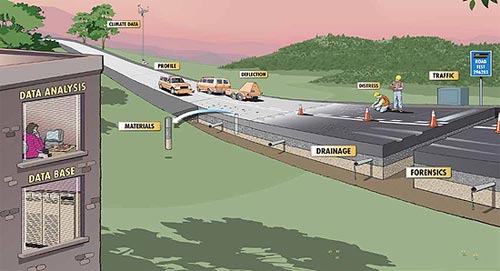
|
LTPP Newsletter |
The Federal Highway Administration (FHWA) has managed daily operations of the Long-Term Pavement Performance (LTPP) program since 1992. Key functions of FHWA’s oversight of the program include collecting performance data from test sections, processing the data, developing and maintaining the database, analyzing the data, and developing products that can be used by the pavement community.
The program has had funding support from Congress since it began in 1987 as part of the Strategic Highway Research Program. While funding support has been provided by various highway bills (from the Surface Transportation and Uniform Relocation Assistance Act to the present day authorization under the Fixing America’s Surface Transportation (FAST) Act), funding levels over the years have steadily declined. To work within these funding levels, FHWA has had to adjust the program’s priorities and activities.
LTPP program staff is preparing a 5- to 10-year plan to cease data collection for certain LTPP test sections. It will take some time to develop the details, but the work and review of existing test sections is underway. This change to the LTPP program, along with other near-term changes, was discussed at the 2017 LTPP State Coordinators’ Meeting. The following are some key highlights from the meeting.
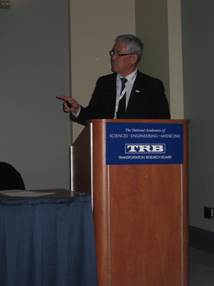 |
| Randy Iwasaki presiding over LTPP State Coordinators' Meeting. |
At the LTPP State Coordinators’ Meeting in January, during the Transportation Research Board (TRB) Annual Meeting, Cheryl Richter, Director of Infrastructure Research and Development, discussed the funding issue and the challenges that are now before the LTPP program.
Reduced funding presents the challenge of adjusting LTPP program activities. It means the program will not be able to do everything that was planned. This decline in funding is not exclusive to the LTPP program—it is an issue for all FHWA research programs.
The LTPP program is a very mature program. Many of the program’s goals have been accomplished and most of the test sections have been monitored for long time periods. As such, FHWA has decided that staffing and funding resources will be shifted to bring the Long-Term Bridge Performance (LTBP) program to a more mature state. The first step in this process, which has already begun, is to merge the LTPP and LTBP teams into the Long-Term Infrastructure Performance Team.
Given the recent retirements of Aramis López, who served as the LTPP Team Leader, and Hamid Ghasemi, who served as the LTBP Team Leader, FHWA believes that now is the time to consolidate the two teams into one and make this organizational change.
Richter emphasized that while the LTPP program will continue, FHWA will need to adjust the way it invests in it. Going forward, FHWA is committed to maintaining LTPP InfoPave™, performing limited data collection, and leveraging other funding sources to support other program activities, such as data analysis.
During the meeting, Michael Trentacoste, Associate Administrator for Research, Development, and Technology, also underscored the point that these funding reductions do not mean that the LTPP program will end. After observing that LTPP and LTBP are FHWA’s two largest research programs, he recognized the importance of future planning and providing value from research endeavors that will benefit State and industry partners.
Keith Platte, Associate Program Director of Project Delivery for the American Association of State Highway and Transportation Officials (AASHTO), also spoke at the meeting. Platte noted that AASHTO, which has been a strong supporter of the LTPP program, is also undergoing a transition to restructure its programs. The goal for the transition is to increase responsiveness. Pavements will be elevated with these changes. Platte observed that if the States find value in the LTPP program, then there are other ways to fund the program. He recognized the exemplary accomplishments of the LTPP program and said that AASHTO is available to help with its next phase.
Randy Iwasaki, a member of the TRB LTPP Committee who stood in for Tom Baker, the Committee Chairman, presented the LTPP Committee Report. Iwasaki emphasized the importance of AASHTO’s involvement in helping to obtain other funding for the LTPP program. He said that State and local agencies need to do a better job talking about the importance of infrastructure. In reference to the LTPP program, he pointed out that although stopping data collection was not desirable, it was necessary, as the program would soon be changing.
While the previous speakers provided a big picture view of the state of the LTPP program, Max Grogg, Acting Team Leader for the program, spoke specifically about how the LTPP program will operate going forward.
Looking at the life cycle of LTPP test sections has been done in the past and is not new for the program, he pointed out. Grogg recognized that the program will not be ending and how the life-cycle review is an opportunity to measure its progress and plot future steps. (See the following graph.)
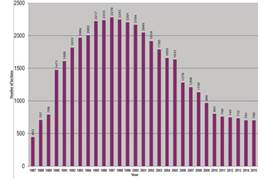 Based on the data completion analysis and other factors, 63 LTPP test sections will have one last performance data point in 2017. Looking to future years, it is anticipated that by the end of Federal Fiscal Year 2018, data collection will stop for about 150-200 test sections. And between 2019 and 2021, monitoring activities will stop for approximately 100 test sections per year. In 2021, it is expected that the LTPP program will still be collecting monitoring data for high-priority test sections such as the SPS-2 (Strategic Study of Structural Factors for Rigid Pavements), SPS-10 (Warm-Mix Asphalt Overlay of Asphalt Pavements), and other test sections that could have a strong impact in helping to better understand the behavior of pavements. These remaining 150 or so test sections will then be re-evaluated to determine what should be done beyond 2021. In spring 2017, the LTPP program office will send written letters to highway agencies informing them of the status of their LTPP test sites.
Based on the data completion analysis and other factors, 63 LTPP test sections will have one last performance data point in 2017. Looking to future years, it is anticipated that by the end of Federal Fiscal Year 2018, data collection will stop for about 150-200 test sections. And between 2019 and 2021, monitoring activities will stop for approximately 100 test sections per year. In 2021, it is expected that the LTPP program will still be collecting monitoring data for high-priority test sections such as the SPS-2 (Strategic Study of Structural Factors for Rigid Pavements), SPS-10 (Warm-Mix Asphalt Overlay of Asphalt Pavements), and other test sections that could have a strong impact in helping to better understand the behavior of pavements. These remaining 150 or so test sections will then be re-evaluated to determine what should be done beyond 2021. In spring 2017, the LTPP program office will send written letters to highway agencies informing them of the status of their LTPP test sites.
Although the program has always had four contractors to collect data in the four LTPP regions, only one data collection contractor will collect the monitoring data in the coming years. The regions will remain as is, but because of the reduced number of test sections that will be monitored, one contractor will be sufficient for collecting the data in all four regions.
A casualty of the reduced funding for the LTPP program under the FAST Act is the program’s inability to help the States monitor the long-term performance of pavement preservation treatments. At the request of many highway agencies, the LTPP program began the process to form pavement preservation experiments for both asphalt and concrete. The program has completed the experimental designs for both pavement types and encourages States to use this information. Grogg observed that FHWA cannot lead a pooled-fund study for these new experiments, but would support a State-led initiative.
The program will maintain the database by adding new data as they are collected, and keep the database current as technology changes. However, the website, LTPP InfoPave™ which is used to provide access to the database, will not have any new enhancements after 2018. At that time, the website will be in maintenance mode.
Data analysis is one area of the LTPP program that is expected to grow in coming years. The program plans to conduct at least one data analysis study a year using the funds provided by the FAST Act.
Quality is a priority of the LTPP program and has not been compromised with reduced funding levels. Providing quality pavement performance data to the users will continue to be a program priority.
Jack Springer, LTPP Team Member, covered the need for performing forensic investigations as test sections go out-of-study. He also discussed the status of the LTPP pavement preservation experiment.
The Washington State Department of Transportation is leading a pooled-fund study, “Performing Forensic Evaluations of LTPP Remaining Sections Before They Leave Service”, TPF-5(332), that States can join. He mentioned if an agency would like to conduct a forensic investigation, the LTPP program can help. Those interested in participating can contact their LTPP Regional Support Contractor.
Springer then transitioned to the pavement preservation study. The LTPP program has developed an experimental design for conducting asphalt and concrete preservation to answer the question, “When is the appropriate time to place a treatment?” Based on previous budget discussions, the LTPP program is unable to commit to the monitoring requirements (estimated at $200,000 per project). It is therefore encouraging States to form a pooled-fund study to carry the experiments forward.
While addressing the challenges facing the LTPP program, the team has also been working on products to help the pavement community. Larry Wiser, LTPP Team Member, informed the group of two new tools that are available on LTPP InfoPave™ for users. They are the LTPP Climate and LTPPBind tools. The climate tool is a result of the need for the LTPP program to update the climate data in the database. The program used the climate data that is continuously collected by the National Aeronautics and Space Administration (NASA), known as the MERRA (Modern-Era Retrospective Analysis for Research and Analysis) data. The data provides hourly coverage for the entire country which is an input parameter for the AASHTOWare® Pavement ME Design software. The Joint Technical Committee on Pavements is considering using this detailed climate data to update the climate module in the ME Design software. The use of this climate tool has far-reaching impacts beyond pavement and bridge applications.
The LTPPBind Online tool was developed to help pavement engineers calculate the performance grade (PG) asphalt binder based on certain inputs, such as climate data. The original LTPPBind product was a stand-alone software that was not regularly updated. Now that the software is online, users have the ability to enter climate data from MERRA, the LTPP database, and other sources to calculate the PG binder. This new online tool allows for more flexibility and produces accurate results.
Riaz Ahmad, a LTPP contractor, covered new features and updates to existing features on the LTPP InfoPave™ website.
Some of the exciting new features include a “Virtual Section,” which is used to visualize LTPP test sections in 3D. Another feature that can be used immediately by the States is a Forward Calculated Stiffness tool, which generates a ball-park estimate of the stiffness of the surface asphalt or concrete layer(s) and the subgrade soils based on user-input falling weight deflectometer data. Pavement performance data, as well as the accompanying reports from the FHWA Rigid Pavement Performance and the Rehabilitation study, are now part of the Non-LTPP module. Another important addition is a set of National Pavement Performance Measures. This new web-based tool displays the calculated national pavement performance distress measures based on LTPP data using the interpretation methods from the Highway Performance Monitoring System (HPMS) and the proposed FHWA final rules for performance management.
In his closing remarks, Grogg said that the LTPP program has always been a partnership with the States and industry. This partnership will continue even though this marked the last official LTPP State Coordinators’ Meeting after nearly 30 years of holding this event on the Sunday prior to the start of the TRB Annual Meeting.
FHWA extends its gratitude to the TRB planners and organizers of this meeting who provided a meeting space over the years. It also wishes to thank the members of the TRB LTPP Committee and the TRB Special Activities Expert Task Group for their support and advice over the past year and for assisting the LTPP program staff.
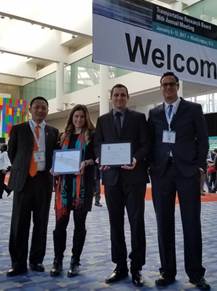 |
| Kelvin Chen-Ping Wang with Giannin Viecili, first place Graduate Category winner, Michael D. Elwardany, The Aramis López Challenge Category winner, and Muhammad Amer |
Winners of the data analysis contest were also recognized for their accomplishments at the LTPP State Coordinators’ Meeting.
For the past several years, the American Society of Civil Engineers (ASCE) and the LTPP program have been partners in the ASCE-LTPP International Data Analysis Contest. This year, both partners were pleased to receive exceptional papers from students and were delighted to make a first place award in two of the four contest categories.Student team members, Michael D. Elwardany, Kangjin Lee, Jung Hwa Lee, and Coleman Brown, from North Carolina State University, worked under the supervision of theiradvisers Cassie Castorena and Y. Richard Kim and won first place in the challenge category for their analysis of “Proposed Performance Prediction Equations and Threshold Triggers for Thin-Overlay Treatment Using LTPP Database.” They are the first winners to receive The Aramis López Challenge Category Award, which was named in honor of López upon his retirement from FHWA. Elwardany and Brown presented their work at the LTPP Technical Session during the TRB Annual Meeting.
Giannin Viecili, from the University of Toronto, won first place in the graduate category for her analysis of the “Investigation of Rutting & IRI as Pavement Condition Indicators as Per Ministry of Transportation Ontario Guidelines.”
Papers are due June 1, 2017 for the 2016-2017 contest.
“Long-Term Pavement Performance: Debut of Latest Products and Research Results” was the theme of the LTPP Technical Session (held January 9, 2017). Larry Wiser briefly discussed the “LTPP Climate and LTPPBind Tools” at the State Coordinators’ Meeting.
He offered details of the MERRA data grid and what data elements are available through the LTPP Climate Tool located on the LTPP InfoPave™ website. As a result of this development, pavement engineers now have the ability to download the climate data in a format compatible with the AASHTOWare® Pavement ME Design software. Data from the LTPP Climate Tool can be downloaded in various formats, such as Microsoft® Excel®, Access®, or SQL®. MERRA climate data for MEPDG is exported as hourly climatic data or HCD files that are inputs for the Enhanced Integrated Climate Model.
Wiser also covered updates made to LTPPBind Online, which also resides on the LTPP InfoPave™ website. This tool has moved from a stand-alone software to a Web-based system that allows for easier access and upgrades. Just as with LTPPBind 3.1, LTPPBind Online calculates the asphalt binder based on pavement temperature, maximum rut depth, desired level of risk, traffic loading, and speed. LTPPBind Online accepts climatic data from a number of data sources such as MERRA, the LTPP Climate Module, or user defined input.
The Moving Ahead for Progress in the 21st Century Act required FHWA to adopt pavement performance measures to evaluate conditions for both the Interstate and National Highway Systems. The HPMS data was selected as the data source to develop the performance measures for the international roughness index (IRI), percent cracking, faulting, and rutting. To assist FHWA in examining the accuracy of these measures, the LTPP program initiated a data analysis study to use the data from the LTPP test sections. It made sense to do this because of the wealth of information in the database and the good time-series data that is available for hundreds of different locations.
Gonzalo Rada led this research effort and provided findings in his presentation, “Validation of Pavement Performance Measures Using LTPP Data.” According to Rada’s findings, the LTPP data met or exceeded what was in the proposed rulemaking as far as data collection specifications, and, as expected, the condition of the pavement generally gets worse with time. There were some issues with the precision for faulting and rutting. Increasing the cracking percent condition threshold decreased the number of poor performance pavements. The question is how long does it take for a pavement to go from good to fair to poor? Using temporal analysis and data from the LTPP seasonal monitoring program, the average time for the overall condition to deteriorate was 4 years for asphalt concrete (AC) pavements and 12 years for continuously reinforced concrete pavement (CRCP). It takes time for a pavement to go through these different stages and the analysis has shown that the overall condition rating is fairly static over time and against maintenance and rehabilitation activities. While cracking and rutting were driving the overall condition rating for asphalt pavements, all four metrics (IRI, percent cracking, faulting, and rutting) contributed to the overall condition rating for the various pavement types. Guidelines are being developed to help State highway agencies understand what must happen to move performance measures from poor to fair or from fair to good, or to prevent pavements from slipping from good to a lesser condition state for Interstate pavements.
Harold Von Quintus’ presentation on the “Characterization of Existing Hot Mix Asphalt Layer Damage on Mechanistic Pavement Rehabilitation Design” is based on his results from a recently completed LTPP data analysis study. This study was to provide a proof of concept for estimating the in-place damage of hot mix asphalt layers for use in rehabilitation design using the Mechanistic-Empirical Pavement Design Guide (MEPDG) approach. The objective was to develop and calibrate enhancements for characterizing existing flexible pavement damage for overlay design that can be integrated into the current AASHTOWare® Pavement ME Design software. The project focused on the review of existing overlay design procedure using the MEPDG input level 1 rehabilitation methodology. In this study, Von Quintus evaluated six assumptions (or hypotheses), of which over half were accepted.
The final presentation at the technical session, delivered by Michael D. Elwardany and Coleman Brown, was based on the winning paper in the challenge category of the ASCE-LTPP international data analysis student contest. Elwardany’s and Brown’s analysis of the “Proposed Performance Prediction Equations and Threshold Triggers for Thin-Overlay Treatment Using LTPP Database” aimed to develop guidelines to determine the optimal time of application; develop performance prediction equations; and investigate performance based on climate, traffic, existing AC overlay thickness, and overlay thickness.
The student team evaluated LTPP data from the SPS-3 (Preventive Maintenance Effectiveness of Flexible Pavements) and SPS-5 (Rehabilitation of Asphalt Concrete Pavements) test sections. Fatigue cracking, longitudinal cracking in the wheelpath, and rutting were the performance indicators used to determine the life gained from thin-overlay treatments. They concluded that the lifegained as a result of a thin-overlay treatment in terms of longitudinal cracking in the wheel path is highly dependent on traffic levels, not just truck traffic; and the life gained as a result of thin-overlay treatment in terms of rutting performance is highly dependent on the existing AC layer thickness. The team also found that the less severe the surface distresses, the longer pavement life thin-overlays provide.
 |
| Aramis López, the LTPP Team Leader, recently retired. |
On September 20, 2016, present and former colleagues, friends, and family gathered at the Turner-Fairbank Highway Research Center to celebrate the retirement of Aramis López and to recognize his contributions to the Federal Government; in particular, his role as the enthusiastic and dedicated LTPP team leader since 2001.
All four previous LTPP team leaders attended the event and gave complimentary (and, yes, funny!) remarks about working with Aramis over the years. Aramis was surprised to learn that the Challenge Category for the ASCE-LTPP International Data Analysis Contest was renamed in his honor to The Aramis López Challenge Category.
Aramis displayed passion for his work and compassion for the people who carried out the work with him. His work with the LTPP program is finished, but the work of the program continues with the team he worked so closely with since 2001.
The LTPP program lost two members of its extended family earlier this year: Ted Scott of the American Trucking Association and Andrea Baker of ASCE.
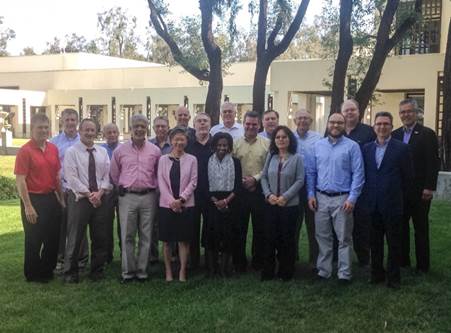 |
| TRB LTPP Committee Meeting, National Academy of Sciences Beckman Center, Irvine, CA (March 2016). Ted Scott is standing in second row between Pat Hu (in pink sweater) and Debbie Walker (gray scarf). |
Ted served on the TRB LTPP Committee since the late 1980s. He was a strong supporter of the program. He and other members of the committee solicited funds from private donors when FHWA was no longer able to provide cash prizes to student winners of the ASCE-LTPP International Data Analysis Contest. Ted was always candid in his comments at committee meetings with the LTPP program staff and would do what he could to promote the program.
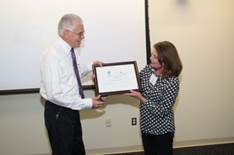 |
| Andrea Baker presents Aramis López with a certificate recognizing the renaming of the challenge category award to The Aramis López Challenge Category. |
Andrea worked closely with the LTPP program staff to promote the data analysis student contest that ASCE and FHWA have been partners in since 1998. She was the point of contact for the students and the LTPP program and handled every detail of the contest. She worked with Ted Scott and others on the LTPP Committee to receive the funds donated by private organizations for the cash prizes, and she also worked with this same group (along with FHWA) to rename the challenge category and recognize the contributions Aramis López made to the LTPP program. Andrea was such a joy to work with and so much fun to talk to.
The LTPP Team is grateful to have had the privilege to work with these two vibrant and extraordinary people.
The Long-Term Pavement Performance Program - Book
FHWA-HRT- 15-049
September 2015 [PDF]
TechBrief - Long-Term Pavement Performance Program—Pavement Performance Measures and Forecasting and The Effects of Maintenance and Rehabilitation Strategy on Treatment Effectiveness
FHWA-HRT- 16-046
April 2016 [PDF]
Pavement Performance Measures and Forecasting and The Effects of Maintenance and Rehabilitation Strategy on Treatment Effectiveness
FHWA-HRT- 16-047
January 2017 [PDF]
FHWA LTPP Guidelines For Measuring Bridge Approach Transitions Using Inertial Profilers
FHWA-HRT-16-072
December 2016 [PDF]
Analysis of Cracking in Jointed Plain Concrete Pavements
FHWA-HRT-16-073
March 2017 [PDF]
TechBrief - Impact of Environmental Factors on Pavement Performance in The Absence of Heavy Loads
FHWA-HRT-16-078
December 2016 [PDF]
Product Brief:
Long-Term Pavement Performance Bind Online
FHWA-HRT-17-009
March 2017 [PDF]
Product Brief:
LTPP Climate Tool
FHWA-HRT-17-011
January 2017 [PDF]
LTPP InfoPave - Release 2017 - What's New
FHWA-HRT-17-030
January 2017 [PDF]
Join us on social media to find FHWA's latest news, information, and resources.
HRDI-30/3-17(Web)E
FHWA-HRT-17-103